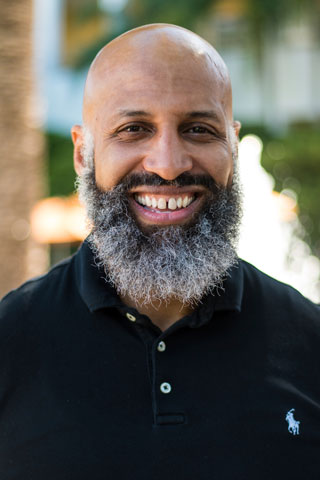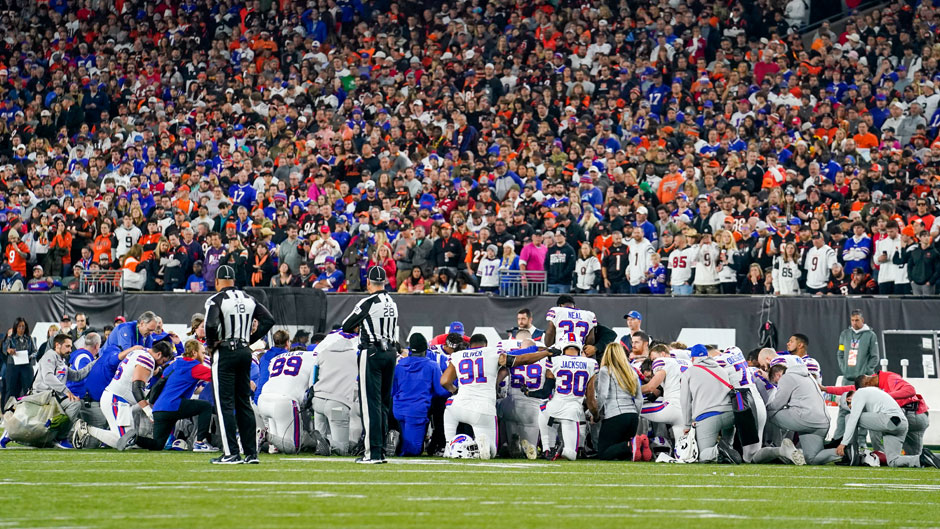Along with millions around the country, Tywan Martin and Kysha Harriell both tuned in on national television Jan. 2 to watch the high-stakes NFL matchup between the Buffalo Bills and Cincinnati Bengals. After Damar Hamlin’s jarring tackle, they saw the 24-year-old Bills safety rise momentarily, then collapse into cardiac arrest.
Martin and Harriell, an associate professor and clinical professor, respectively, in the University of Miami School of Education and Human Development’s Department of Kinesiology and Sport Sciences, are both lifelong football fans. The urgency on the field, as medical personnel raced toward Hamlin, was powerfully reminiscent for both.
“The second I saw the hit, it harkened me back to Lawrence Taylor’s tackle on Joe Theismann in 1985. I saw that live,” Martin said. “Taylor was jumping up and down—many thought he was celebrating the sack, but we know now that wasn’t the case. He’s a human being and was waving for medical staff because Theismann had fractured his leg so severely.”
That same crushing tackle that ended Theismann’s career is etched in Harriell’s memory. As a young girl growing up in Washington, D.C., she was fascinated with the game that bonded her with her father, brother, and other family members.

“I remembered being devastated. Theismann was my hero, the quarterback of my favorite team,” Harriell said. “And I really got interested in it and wanted to make sure that he was okay and thought that it would be a really cool job to be able to help someone who was injured while doing something that I loved watching.”
The play launched her career to first become a trainer for athletic teams, then earn both a master’s and doctorate degree in the field of sports medicine, in addition to assuming a variety of other roles at the University that include associate dean of Race, Diversity, Equity, and Inclusion in the School of Education and Human Development.
Martin, who wrote his doctorate exploring extreme martial arts, pointed out that violence and football have long been a smooth handoff.
“The violence isn’t new. It’s been around for a long time, and I’m not saying that to be dismissive of the injuries, but instead that the same issues that prompted [then President Teddy] Roosevelt more than 100 years ago to convene leading college presidents and football leaders to demand they clean up the game, are still part of football.”
In 1902, 12 football fatalities were reported, and in 1904, 159 serious injuries and 19 fatalities, according to the Journal of the American Medical Association. After his own son was injured in a game, in 1905 President Roosevelt ordered football leaders to the White House.
Martin suggested the league’s appetite for revenues increases the players’ vulnerability to injuries.
“It’s hard to believe the league is interested in the health and well-being of the athletes when you add a 17th game,” he said. “It’s going to add more money to the league, which means more money for the athletes and more opportunities for the advertisers. So, it’s going to be hard to pull back from that.
“But based on conversations I’ve had with people in the health care system, with trainers, etc., the human body wasn’t made for this, and when you add another game to the slate it increases the chances of extreme injuries,” Martin said.
He both blamed and credited football’s media partners, especially the cable sports channel ESPN, with creating an “insatiable appetite” for the game.

“The media rights holders do a masterful job of curating the brands that they’re in partnership with, in this case the NFL,” Martin said. “It seems like all year long they’re keeping the minor details and major outcomes front of mind—as if you need to have this in your life, and we’ve got to make sure that folk are continuously talking.”
Martin said that he talks about football’s appeal with his students, who all say that they’re frustrated by the hits and injuries. But when challenged to give up watching, few are willing to do so.
“I’m guilty, too,” he admitted. “And the league knows that we will continue to watch. Their media partners assist throughout the year to ensure that there is this demand.”
Hamlin’s injury seemed to captivate the interest of many who were not even fans of the game. What was the interest?
“It was on live television,” Martin said. “We’re talking about a huge game, two really good teams playing—there were a lot of eyeballs on the TV and emotions around the country were elevated that time, and then the continuous replay. Media sets the stage by showing those videos over and over again.”
The game, with an average 23.8 million viewers, was the most watched Monday Night Football game in history, according to media reports.
While football, which emerged in the aftermath of the Civil War, is modeled on war strategies—overwhelming the “enemy,” conquest and defense of territory, formations and more—Harriell emphasized that those strategies are purely symbolic in football.
“There’s no doubt that when you talk about war and soldiers that death is a possibility, but in football we never expect that to be a possibility,” she said. “I’ve watched games where someone was paralyzed or suffered a very significant injury, and then they’ve gotten off the field and given the ‘thumbs up’ to let people know they were okay and breathing, and the game went on,” she added. “But this isn’t war, and people aren’t supposed to die. The fact that it was on the table, changed the game completely.”
Both Harriell and Martin celebrated the potential in football and other sports to create long-lasting bonds between teammates and between the families and fans who root for their teams. The duo agrees that sports games also put amazing athleticism on display and highlight the sense of purpose and satisfaction that players experience collectively working toward a clear goal, such as winning a game or a championship.
But the consequences of injury and new awareness has shifted their approach to the game.
“I used to be one of those people who would get up and cheer after an especially hard hit, like ‘yay, that was amazing’ and not really connecting the hit to the person receiving the injury,” Harriell said. “But as time has gone on, I’ve become more aware of concussions and understand the long-term side effects.”
She has family members and friends, one who needed hip replacements because of old football injuries, who carry the scars of the tough play.
“The more you see and know the more you understand that there’s a lot of sacrifice that goes into playing the game,” Harriell said. “I think our awareness and how we are entertained by football is changing—better ‘consciousness’ is the word that comes to mind.”
Martin played football growing up, and in high school he once delivered a crushing blow to a teammate in practice that earned him the nickname “T-Bone.”
“In football, there’s a 100-percent chance of injury,” Martin said. “As a young person, I never wrapped my head around the idea of what it meant trying to run at and hit somebody. Now I’m to the point that I can’t imagine running my body into another human spirit.”
Harriell said that above all, Hamlin’s injury and the medical team’s lightning-fast response that essentially saved his life, highlight the value of these service personnel.
“Athletic trainers are key and essential,” she emphasized. “The situation could have been dramatically different without them. If you’re going to play sports—and especially football—people need to invest the resources and understand that an athletic trainer isn’t a luxury anymore. They’re a must.”

